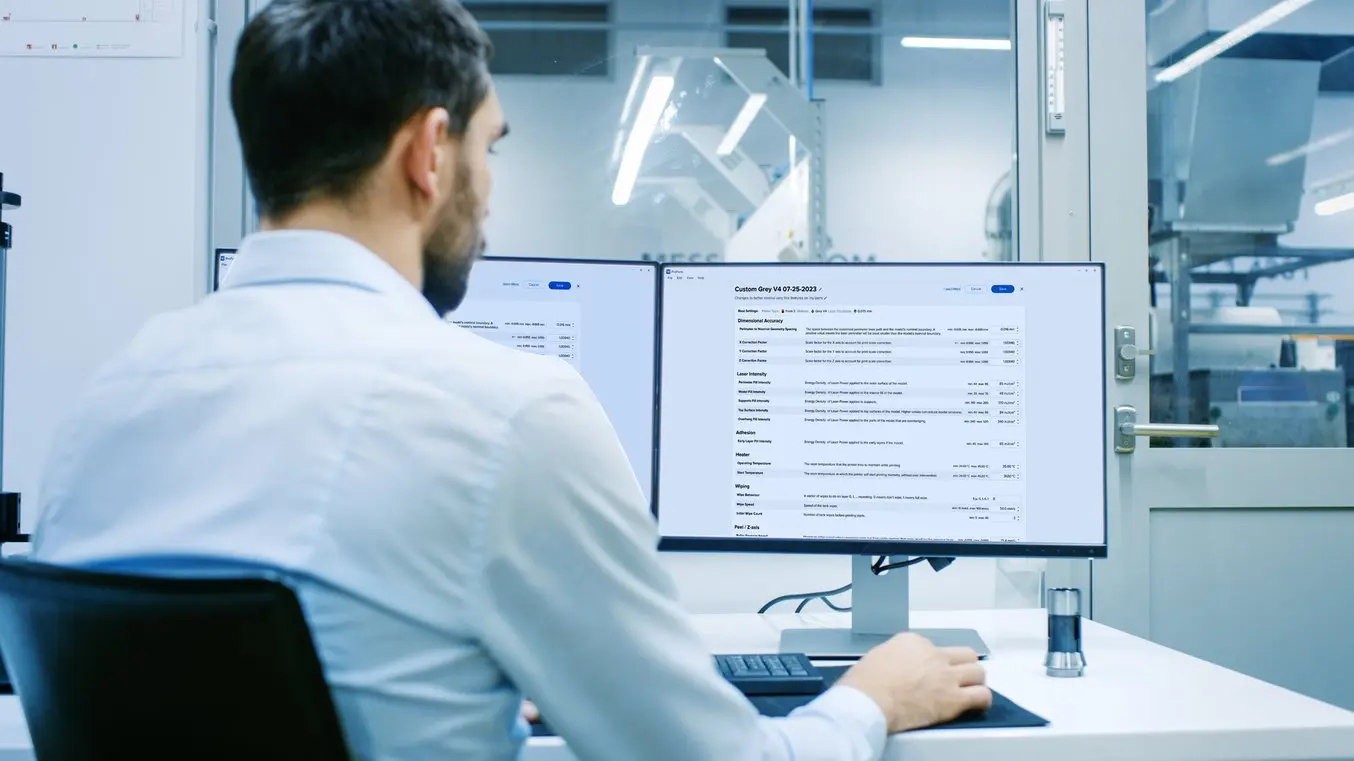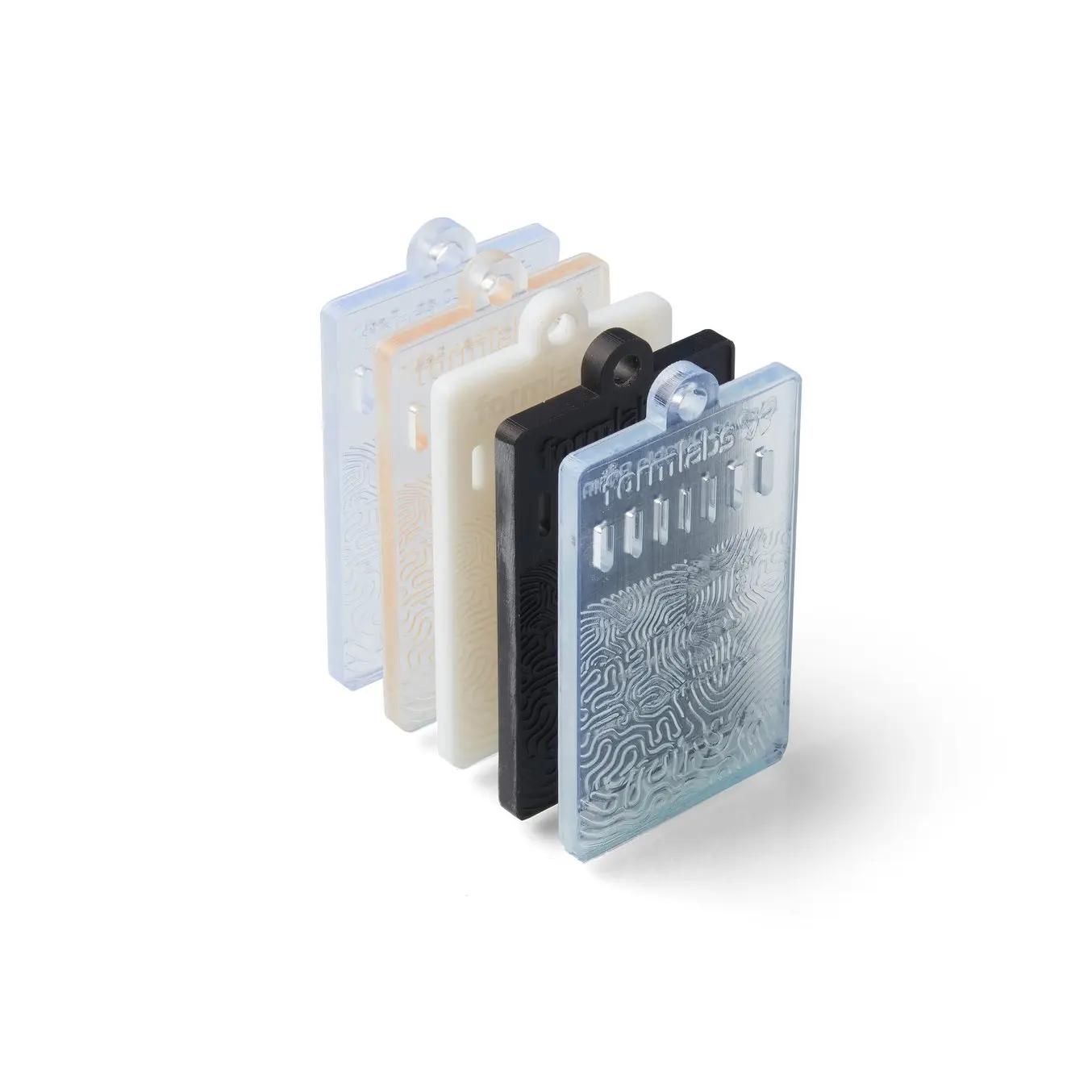광경화성 수지 조형 방식(SLA) 3D 프린터를 사용하려면 레진 3D 프린트를 경화하는 방법을 필수적으로 알고 계셔야 합니다. 파트를 후경화하면 강도가 최고치에 이르는 안정적인 파트 얻을 수 있습니다.그렇지만 레진마다 최적의 물성에 이르는 후경화 소요 시간과 온도 등의 조건이 제각기 다릅니다.
레진 프린트물을 경화해야 하는 이유가 무엇일까요?
Formlabs의 레진은 각각 고도화된 감광성 폴리머 화학물질로 배합되었습니다. Formlabs의 광경화성 수지 조형 방식 3D 프린터는 405nm 레이저를 사용하여 액체 수지를 경화시켜 매우 정밀한 고체 파트를 제작합니다. 빌드 플랫폼 위에서 프린팅을 마친 SLA 파트는 미경화 상태입니다. 최종적으로 의도된 형상으로 출력했지만 중합되지 않은 상태라 파트의 기계적 물성이 부족한 상태입니다. 빛과 열로 후경화하는 과정은 SLA 3D 프린팅에 사용된 소재의 특성을 얻는 핵심 단계입니다. 생체적합성 소재의 경우 후경화를 거쳐야만 관련 규제 기관에서 제시하는 안전 기준을 충족할 수 있습니다.
기능성 및 특수 용도 레진 파트는 최적화된 물성을 달성하기 위해 후경화 공정을 필히 거쳐와 합니다. Formlabs의 두 가지 후경화 솔루션, Form Cure와 Form Cure L의 디자인은 Formlabs 레진으로 제작한 파트를 최적화된 속도와 안정성으로 경화합니다. Formlabs의 엔지니어 팀이 개발한 Form Cure와 Form Cure L은 Formlabs 레진 제품군에 최적화하여 개발했습니다. Formlabs의 SLA 3D 프린터와 동일한 405nm 레이저 조명을 사용합니다. 출력 파트를 내부가 반사 표면으로 뒤덮힌 경화 공간에 넣어 자동 회전하며 조명과 열을 골고루 조사하면 안정적인 후경화 공정이 마무리됩니다.
후경화 공정의 이론과 원리 소개
SLA(선택적 레이저 소결) 프린트 레진은 공통적으로 교차결합 중합체로, 분자 사슬이 길게 이어지는 고분자 또는 길게 연결되는 중합체 (단랑체 및 저중합체)입니다. 길게 연결되는 고분자 소재에 남아있는 반응성 그룹이 빛과 열에 노출되면 중합체간에 교차 결합이 일어납니다.
교차 결합이 증가할수록 인장 강도나 탄성계수와 같은 소재 물성이 개선됩니다. 후경화 공정의 목적은 반응성 그룹을 최대한 결합하여 소재의 물성을 최대한 이끌어내는 것입니다.
특정 레진의 경우 반응성 그룹의 이상적인 결합을 초과한 후경화를 지속하면 취성이 증가하거나 성형 규격을 벗어나는 경우도 있으니 신중해야 합니다. 고로, 후가공 프로토콜은 소재와 파트의 성형 형태에 따라 적절한 시간과 온도를 감안해야 과도한 후가공으로 인한 품질 저하를 막을 수 있습니다.
최적의 후가공 공정은 가열과 함께 시작합니다. 온도 상승은 에너지의 상승을 뜻하고 이는 소재 구성 분자의 유동성, 즉 중합체 복합망(polymer network)의 유동성이 됩니다. 이 고에너지 상태에서 출력 소재에 아직 결합하지 못한 반응성 그룹이 유동성을 얻어 상호 결합됩니다. Formlabs의 후가공 기기 Form Cure와 Form Cure L은 경화 공간 내에 히터를 장착해 희망 경화 온도까지 빠르게 가열하고 후가공 공정에 적정한 온도를 지속 유지합니다.
경화 공간이 적정 온도에 이르면 조명을 조사합니다. 조명의 광자(photon)가 소재에 남은 광중합개시제를 활성화하면 주변부의 반응성 그룹의 교차결합이 완전 전행됩니다. 새로운 교차결합이 체결될 때마다 중합체 복합망이 완성되어가며 소재 물성이 도드라집니다.
레진 내에 교차결합이 더 만힝 체결될수록 복합망의 밀도가 소폭 상승하기 때문에 전체 성형규격에 수축이 발생합니다. 이는 레진을 소재로 하는 3D 프린팅 파트에 전형적인 현상입니다.PreForm은 Formlabs의 무료배포 프린트 파일 사전준비 소프트웨어로, 이러한 수축현상을 예상하고 후가공 경화를 마치고 수축한 프린트의 규격이 기존 CAD 파일의 성형 규격을 만족하도록 계산을 자동으로 마칩니다.

영업팀에 문의
프로토타입 신속 제작이나 최종 사용 파트를 생산하려고 하시더라도, 도와드릴 수 있습니다. Formlabs 영업팀은 고객과 회사의 요구 사항을 정확히 알고 있는 전담 전문가로 구성되어 있습니다.
레진 3D 파트는 얼마나 오래 경화해야 할까요?
이상적인 후경화 환경에서는 최적화된 시간 이내에 소재에 필요한 물성이 생깁니다. Formlabs 일반 용도 레진의 경우, Form Cure V2를 사용하면 1분 만에 빠르게 경화할 수 있습니다. 강도, 뒤틀림 없는 강성 및 내열성이 필요한 경우, Formlabs 엔지니어링 레진을 후경화 하드웨어에 따라 최대 120분까지 후경화할 수 있습니다.
Formlabs은 자체적인 인하우스 후경화 연구를 통해 Formlabs의 다양한 레진 소재별로 최적화된 후경화 환경을 확인했습니다. ASTM(미국재료시험학회)의 방식을 참조하여 Formlabs의 소재 개발 엔지니어들이 소재별로 기계적 물성과 다양한 온도 환경을 실험했습니다.
Form Cure V2, Form Cure V1, Form Cure L V2, 또는 Form Cure L V1에 대한 모든 최신 권장 후처리 설정을 웹사이트에서 확인할 수 있습니다. 소재 데이터 시트에서 경화를 마친 소재의 특정 기계적 특성을 확인할 수 있으니 공식 홈페이지에서 다운로드해주세요.

라디오 플라이어의 제품 개발 엔지니어인 아고스티노 로벨로는 "가장 큰 장점은 Form Cure L의 휨 감소와 치수 정확도 향상으로 결합 어셈블리를 결합하는 시간을 절약할 수 있다는 점입니다."라고 말합니다. 여기에서 자세히 알아보세요.
생체 적합성 재료 및 후 경화
3D 프린팅 역량을 워크플로에 적용하는 치과와 의료 서비스가 증가하며 의존도 또한 증가하기 때문에 3D 프린팅 기기 업체에서는 제조 공정 전반에 걸쳐 완제품 수준의 고성능 생체적합 파트의 안정적이고 안전한 생산을 관리할 방법을 고민하게 되었습니다. 생체적합성 판정을 받기 위해선 후경화 공정을 포함하여 사전 승인된 공정 기준을 면밀히 따라야 합니다.
Formlabs의 기술은 FDA 승인 워크플로를 통해 검증되었습니다. FDA의 생체적합성 기기 승인 기준을 만족하기 위해 Formlabs의 레진마다 출력, 세척, 경화 단계에서 지켜야 할 구체적인 것들이 있습니다.
Form Cure와 Form Cure L는 그 워크플로에 중요한 비중을 차지합니다. 승인 기준을 통과하기 휘한 실험과 철저한 정책 및 규제 검토를 통해 생체적합성 용도를 위한 파트의 검증된 최적 설정과 후경화 소요 시간을 제시하며 이를 토대로 최적의 소재 물성과 기계적 특성, 안전성과 안정성을 확보합니다.
각 재료별 제조 가이드에서 각 재료에 대한 구체적인 후 경화 권장 사항을 확인하세요.

BioMed Resin 색상 견본
BioMed Resin 색상 견본에는 각각 양각과 음각 디자인, 0.5~2.0 mm 컷아웃과 해당 레진의 규제 정보도 구현되어 있습니다.
후경화 방법론
이상적인 포스트 큐어 설정은 최적의 시간 내에 필요한 속성을 달성합니다.Formlabs은 자체적인 인하우스 후경화 연구를 통해 Formlabs의 다양한 레진 소재별로 최적화된 후경화 환경을 확인했습니다. ASTM(미국재료시험학회)의 방식을 참조하여 Formlabs의 소재 개발 엔지니어들이 소재별로 기계적 물성과 다양한 온도 환경을 실험했습니다.
후경화 공정이 소재의 기계적 특성에 미치는 영향을 알아보기 위해 이 안내서는 후경화 공정 전후의 인장 탄성 계수를 비교합니다. Form Cure나 Form Cure L 기기에서 후경화를 거친 다양한 레진 파트의 경도 변화를 관찰했습니다. 인장 탄성계수가 높을수록 작용응력에 의한 성형 규격 변이에 대한 저항력 또한 높습니다. 탄성 계수란 파트 내에 광중합체 사슬망이 얼마나 완전하게 교차 결합을 이루었는지와 관련이 있습니다. 따라서 Formlabs는 측정한 탄성 계수를 토대로 후경화의 완정성을 파악합니다.
3D 프린터로 출력한 모형은 프린트 공정의 레이저 조사로 경화된 레진으로 이루어졌지만 광중합체 결합이 완전하게 이루어진 상태는 아닙니다. 반응성 그룹을 마저 교차 결합한 만큼 강도와 경도, 내열성 기능이 개선됩니다. 후경화 공정은 또한 파트 전반의 성형 규격을 수축합니다. 정밀도와 소재의 기계적 물성 측정은 Formlabs의 후경화 공정을 거친 파트를 기준으로 하며, 출력 시 소재 설정은 동일한 환경에서 성형 규격의 수축을 감안한 설정을 사용합니다. 일부 수지는 후경화가 필요하지 않지만 후경화할 경우 기계적 물성이 변경됩니다.
예시: Rigid 4000 Resin에 권장되는 후경화 설정

이 예에서 Rigid 4000 Resin은 경화 후 첫 15분 동안 탄성률이 급격히 상승하여 116%까지 증가합니다. 15분 이후로는 유의미한 변화가 없습니다.
Rigid 4000 Resin은 유리 충전 복합 소재로 고강성 고강도 파트에 적합하며 응력으로 인한 성형 규격 변형을 최소화합니다. 후경화 공정을 통해 강성과 강도를 직접 높이세요. 유리 극미립자 주변의 고분자기지복합재료를 교체 결합하여 견고하게 만듭니다. Rigid 4000 Resin은 후경화 온도에 영향을 상당히 받습니다. 후경화 온도가 상대적으로 높을 경우, 단시간에 탄성 계수가 큰 폭으로 개선됩니다. 후경화 공정이 15분을 초과할 경우 물성에는 변화가 없으나 외관이 변색(황변)하기 때문에 권장하지 않습니다. Rigid 4000 Resin의 후경화는 일반적으로 Form Cure를 사용한 80 °C 공정이 가장 적절합니다.
후경화 문제해결
파트 후경화의 가장 흔한 문제는 후경화 불충분과 뒤틀림입니다. 파트 강성과 강도가 예상보다 부족할 경우 후경화 불충분이 원인일 수 있습니다. 파트가 두껍거나 비교적 큰 경우 전체 가열에 시간 소요 또한 큽니다. 특히, 조명은 파트 표면을 넘어 내부 경화에 부적합하기 때문에 Form Cure와 Form Cure L은 조명과 열을 함께 사용합니다. Formlabs에서 기준 제시를 위해 실험한 규격을 크게 벗어나는 파트의 경우 내부 경화 완료를 위해 일반적으로 후경화 공정에 추천하는 적정 시간이나 온도를 벗어날 수 있습니다.
후경화 공정 중 뒤틀림이 발생하는 경우는 보통 파트에 박막이나 벽이 특히 얇고 조명이 골고루 조사되지 않아서입니다. Form Cure와 Form Cure L는 뒤틀림을 방지하기 위해 후경화 공정 중 턴테이블을 회전해 골고루 조사하며, 테이블 아래에서도 조명을 조사합니다.
보통 후경화를 마친 파트는 미경화 파트보다 취성이 증가합니다. 일반적으로 영률이 증가함에 따라 연신율이 감소하므로 과도하게 경화된 파트는 바람직하지 않게 부서질 수 있습니다.
후경화 하드웨어
간단하게 빛(자연광, UV 네일 살롱, UV 경화 스테이션, DIY UV 경화 상자)으로 경화하는 데서부터 빛과 열을 모두 사용한 경화까지 다양한 후경화 방법이 있습니다. 열은 공정을 가속하고 분자간 결합이 훨씬 더 완전해지도록 하여 재료의 물성을 빛만으로는 달성할 수 없는 수준까지 증가시킵니다.
Formlabs는 2017년 초에 Formlabs 레진 전용으로 제작된 최초의 후경화 하드웨어 제품인 Form Cure V1을 출시했습니다. 이후 Form Cure와 대형 Form Cure L을 업데이트하여 후 경화 시간을 최대 6배까지 단축했습니다.
Formlabs의 데스크톱 및 대형 SLA 전문 3D 프린터용 후경화 솔루션인 Form Cure와 Form Cure L은 Formlabs의 레진으로 프린팅한 파트를 빠르고 일관성 있게 후경화하도록 설계한 제품입니다. 각 Formlabs 레진에 대한 사전 설정된 시간과 온도 설정을 통해 Form Cure 및 Form Cure L은 후경화 공정에서 추측을 배제하고 생체 적합성 등급 또는 디바이스의 요구 사항을 충족하는 생체 적합성 레진을 안전하게 프린팅할 수 있습니다.새로운 레진이 출시되면 기존 사용자는 Form Cure L에 펌웨어 업데이트 기능으로 최신정보로 최적화된 소재 경화 설정값을 받을 수 있습니다.
Form Cure는 405nm 주파 레이저 광원을 사용합니다. 이는 철저한 내부 검증과 테스트를 통해 발견한 주파수로, Formlabs 프린터로 제작한 파트에 가장 우수한 탄성계수와 인장 강도를 완성하는 조건으로 확인했습니다. 경화 시간과 온도를 그대로 유지하고 365nm 주파 레이저 광원을 조사한 경우, 탄성계수가 405nm 파트 대비 67%에 그쳤습니다. 후경화 물성은 경화 공정 시간이 짧을 수록 레이저 광원의 주파수에 상당한 물성의 차이를 보였습니다.

Form Cure L은 대형 파트 후경화를 위한 규격이지만 소규모 배치 대량 생산에도 우수한 효율을 자랑합니다. 치과 기공소에는 5대의 Form 4B 3D 프린터가 있지만, 모든 파트를 한 번에 경화하기 위해 단 한 대의 Form Cure L만 있으면 시간, 공간, 노동력을 절약할 수 있습니다.
SLA 레진 3D 프린트 경화 시작하기
Formlabs는 SLA 3D 프린팅 워크플로를 완성하는 손쉬운 대량 및 소량 파트 경화 옵션을 제공합니다. Formlabs 내외의 검증과 실험을 통해 Form Cure와 Form Cure L은 손쉬운 SLA 생산 확장성을 제공합니다.
Formlabs 재료에 대한 사전 프로그래밍된 설정을 통해 Form Cure 및 Form Cure L에서 파트 후 경화를 쉽게 할 수 있으며, 새로운 프리셋을 저장할 수도 있습니다. 파트 경화를 쉽게 시작하려면 대형 파트 또는 처리량이 많은 응용 분야용 Form Cure 또는 Form Cure L을 구입하세요. 레진 경화 시간 및 온도에 대한 포괄적인 최신 목록은 지원 사이트 리소스에서 확인하세요:
자세한 내용은 Form Cure 및 Form Cure L을 살펴보거나 영업팀에 문의하세요.